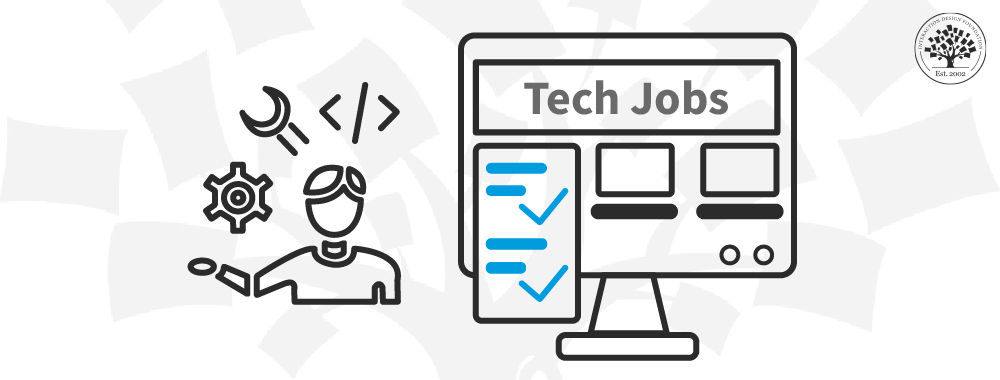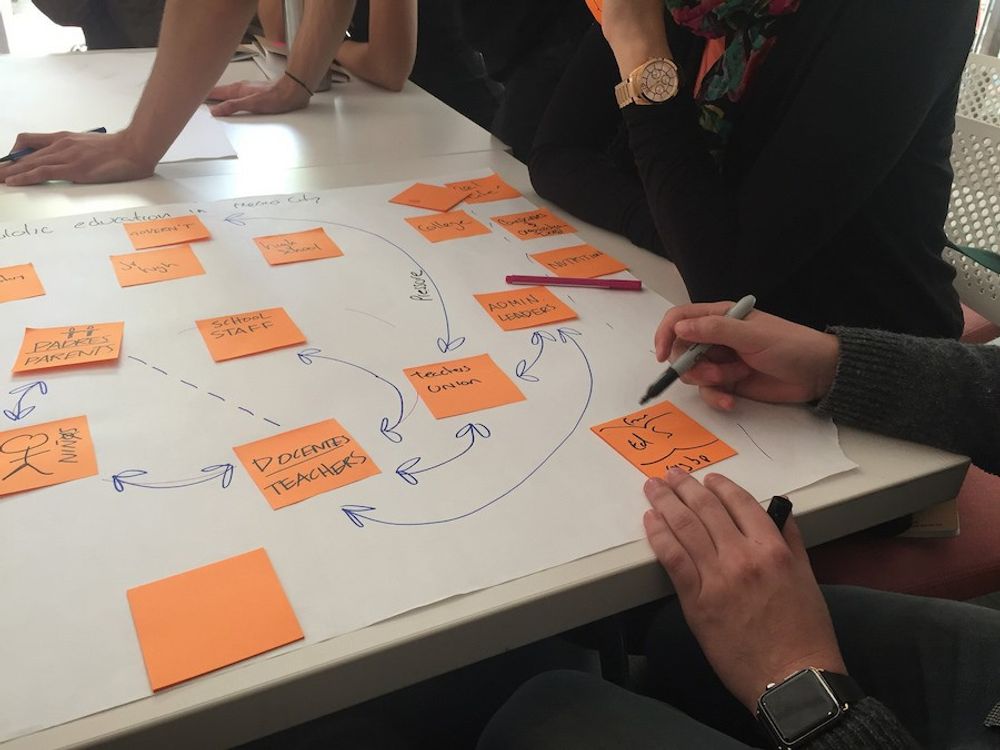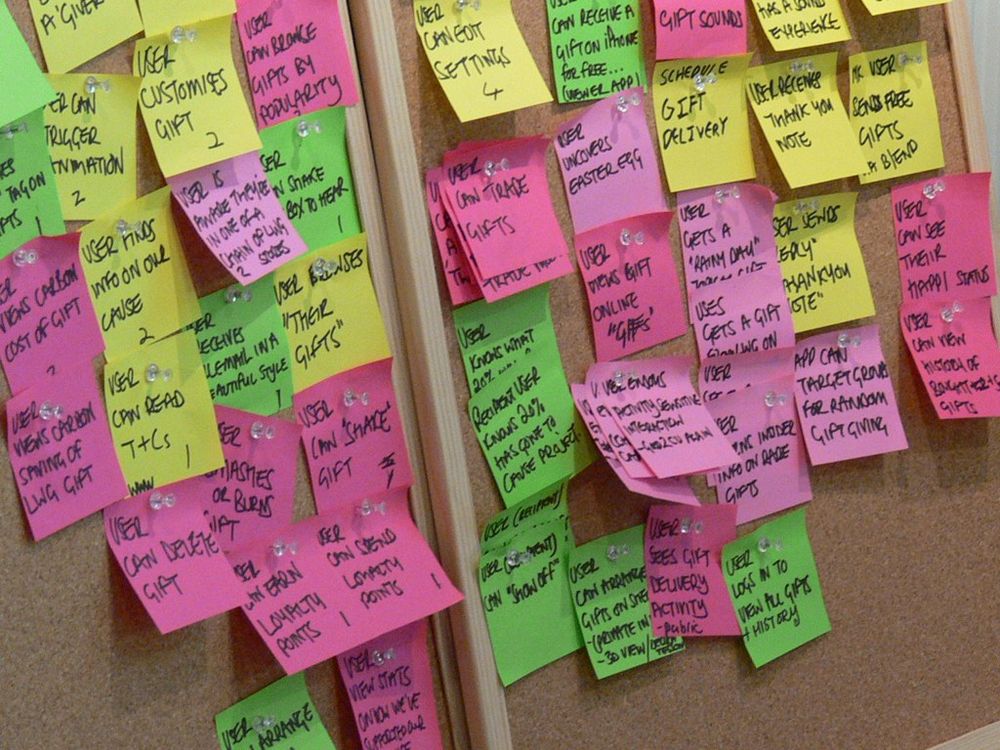Think about which tech career is right for you and you may well find that choosing a career is about getting work that offers fulfilling employment, personal growth opportunities, and—of course—good remuneration. If you’re finding yourself contemplating a change or exploring alternative paths on your professional journey, you’re looking at an exciting and vivacious industry in tech, and you’ll want to read on and get some powerful insights to uncover your tech potential and throw open the doors on new adventures that pay dividends and reward in other ways, too.
How to Understand the Tech Industry
The tech industry is a vast and dynamic field, and one that’s alive and well and undergoing constant change in the 21st century with exciting new developments, technologies, and concepts arising from foundations that are both new and old. With all that, it’s easy to see how it can have so many roles and specializations going on within it, and you’ll want to understand how tech roles in a company, namely geared around software development, are tailored to fit together—as well as what makes them unique.
Data analysts are the “magicians” behind how data has the power to transform decision-making—not least since data is considered king and the keys to the enterprise in how to unlock what customers and users want—putting data analysts in high demand. They’re the ones who collect, analyze, and interpret large data sets to derive valuable insights from the facts and figures and make data-driven decisions that propel brands’ products and services to successful outcomes.
These data handlers explore unstructured data to make data-driven decisions, identify trends, and solve complex problems that might otherwise seem insensible. Data scientists use machine learning models and algorithms to solve complex problems, and what happens is the resulting insights uncover patterns and trends that help organizations optimize their operations and strategies so their brand offerings nail it on the head with the target audience.
Front-end Developers – are the next group of “magicians” to look at—and for anyone who’s ever visited a website and gone, “This website is amazing!” part of the credit for that goes to front-end developers, and they’re professionals who specialize in building and implementing a website’s—or application’s—interactive elements.
Full-stack developers are the ones who make sure that web pages are appealing, functional, and user-friendly as well, and they craft and maintain interactive web pages to guarantee smooth navigation and optimal performance across various devices—because it’s not enough just to get the visual elements right on any website. So, they’re responsible for building websites—as in, from scratch—and they’re skilled in front- and back-end web development both. Unlike front-end developers, who focus just on the visible content for the public, full-stack developers have got a more comprehensive understanding of the entire development process and get both sides of the equation covered.
UX (user experience) designers are the next group of “magicians” (and that’s not to say that this list is in an order of importance—or that the awesome nature of what they do diminishes as you read on!), and designers create meaningful and enjoyable user experiences for users when they’re interacting with digital products. They’ve got to consider the target audience’s needs, do the ground work with user research, conduct prototype testing, gather more usage data, and use their knowledge of design principles to make sure that the final product meets user and business objectives both and hits the ground running in the marketplace—and gets to win.
Learn how technology has transformed our everyday lives in this piece by CEO of Syntagm, William Hudson | How Has Technology Evolved to Affect Your Daily Life?
What are Factors to Consider When Choosing a Tech Job?
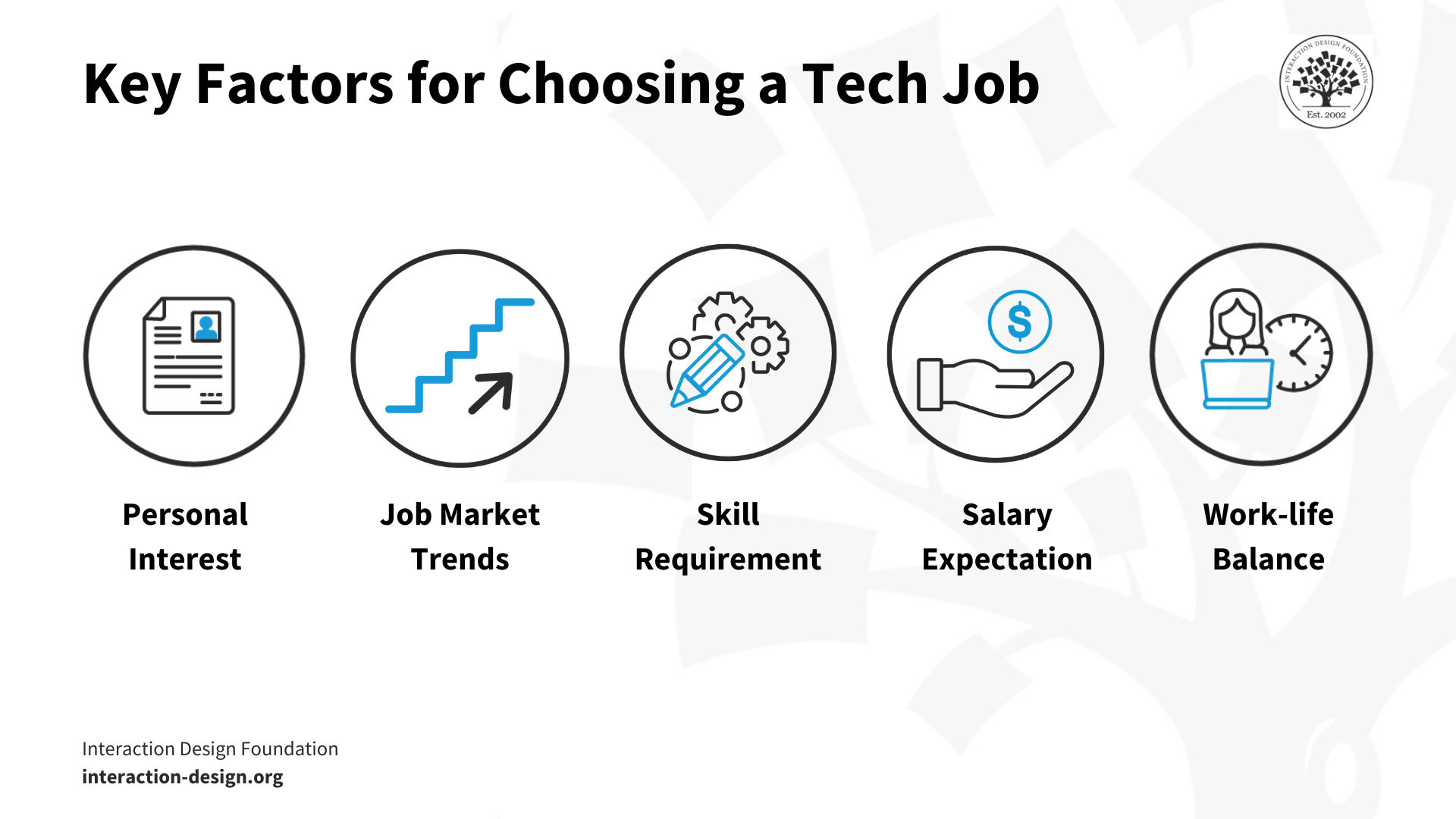
© Interaction Design Foundation, CC BY-SA 4.0
1. Personal Interests and Strengths
Reach in deep and ask yourself if you like working with complex problems, or if information technology fascinates you—or are you more interested in playing with numbers and data? Maybe you love the visuals as one part of how you’ll thrive by designing user interfaces—but in any case, that’s why it’s vital to consider the tech domain that excites you and where you can succeed, so you pursue a tech job that aligns with your interests; it’ll make your work more enjoyable and fulfilling.
2. Skill Requirements and Growth Opportunities
Research, assess, evaluate—these three golden words can help you understand the skill requirements of different tech roles, and—what’s more—you’re going to need to have good people skills for roles like UX designers. That’s not to say that good communication skills don’t apply to more systemized roles like a data analyst or a front-end developer; you’ll still need those to collaborate with stakeholders so everybody can be on the same page nice and clear.
Growth opportunities are another “bucket” to look deep into here, and that’s why it’s pretty much vital to look for expanding industries or domains, offering room for career advancement and skill development. Sure, the tech industry in all its many faces and forms is growing, but it still takes having an eye on the “ball” to spot what’s hot and what’s not.
3. Job Market Trends and Demand
Read up on (or watch up on!) and stay informed about the job market trends and the demand for specific tech roles—in particular, research which industries are experiencing significant growth and high demand for professionals with your desired tech job skills. Many emerging technological trends like AI, cyber security, cloud computing, virtual reality, augmented reality, and blockchain are coming up with new tech roles—exciting times, indeed, to find a job that’s right up your street.
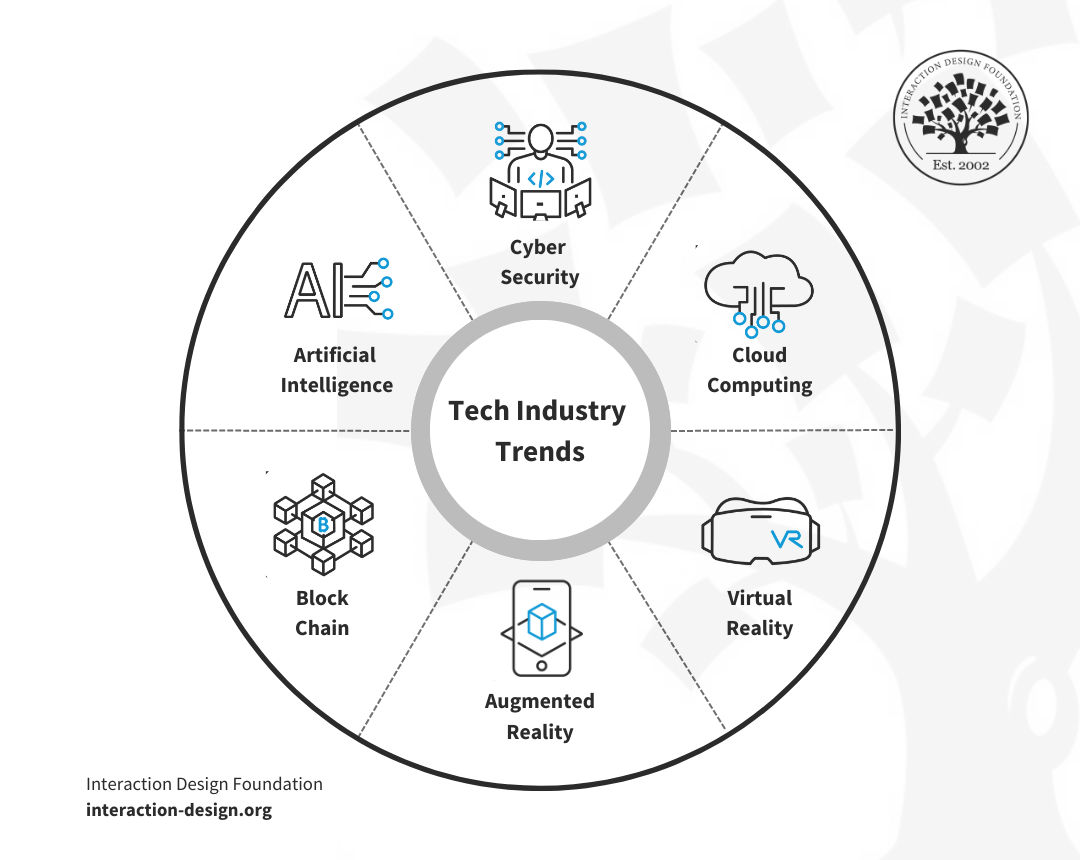
© Interaction Design Foundation, CC BY-SA 4.0
4. Salary Expectations
It’s a financial world, for sure, and although “gold” alone shouldn’t be the prime part of passion for a career, it is vital to not forget that rewards extend far beyond career satisfaction in and of itself. Think about the long-term earning potential and growth prospects—for real, as you’ll want that financial stability to mirror a blossoming career path that can offer further financial security later on, too.
5. Work-Life Balance and Company Culture
Factors like work hours, flexibility, remote work options, and company values are going to play big parts in your picking process. When you’re sure that a work environment is one that promotes your well-being and professional growth—and one that gives you a chance to be part of something exciting but doesn’t keep you pinned down for so many hours a week that your family and friends forget what you look like—you’ll be better placed to proceed with confidence building a rewarding and successful tech career path.
How About an In-depth Look at Key Tech Roles?
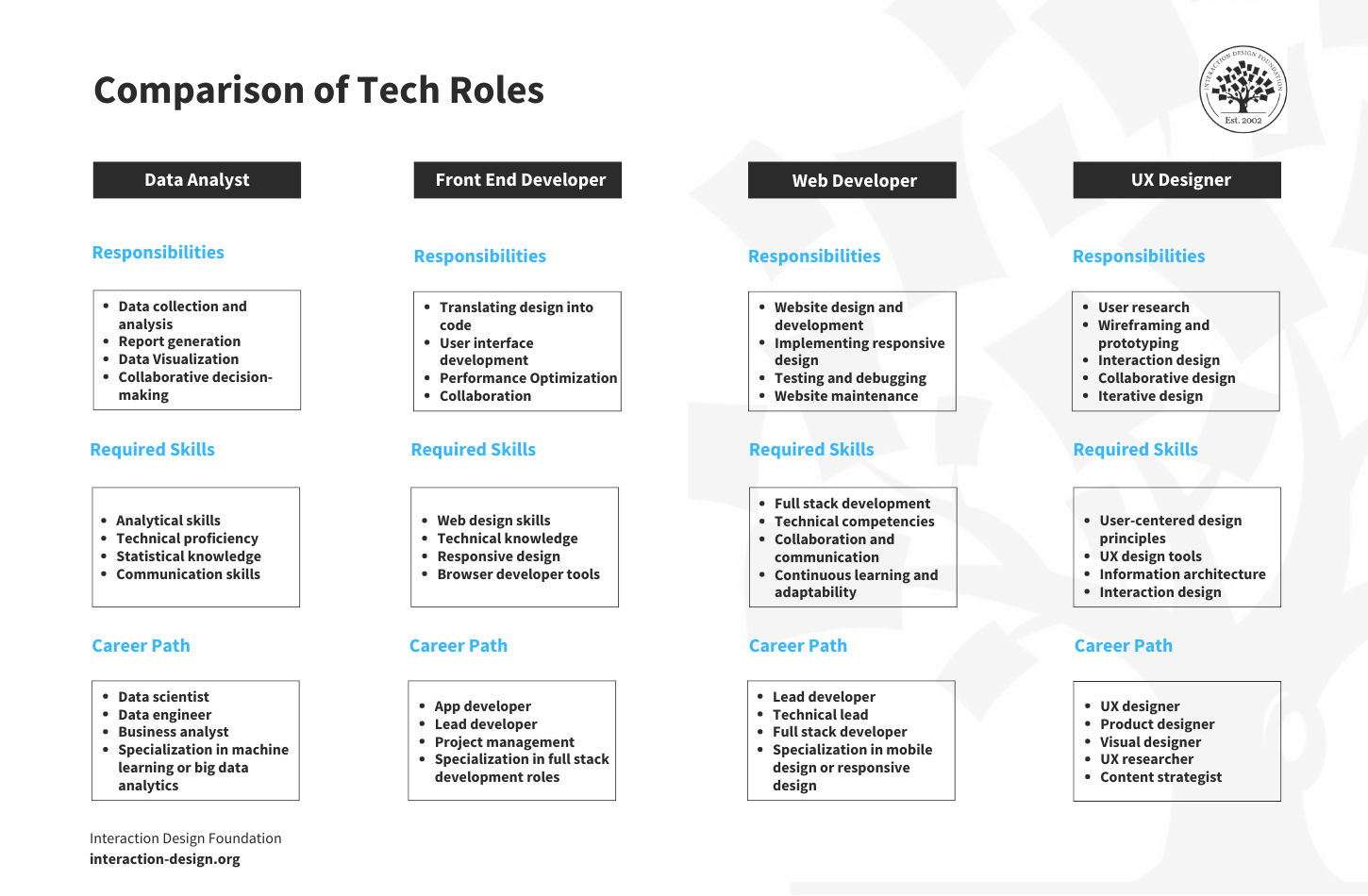
© Interaction Design Foundation, CC BY-SA 4.0
Download this handy reference sheet (shown above) as a template to guide you in your decision-making process here:
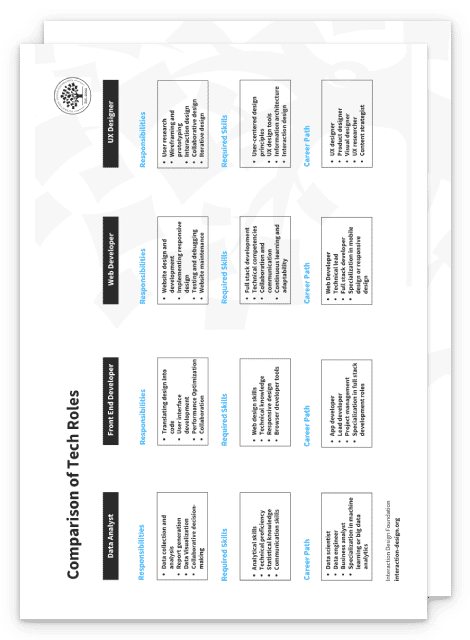

Data Analysts
What skills and qualifications are required to become a data analyst?
You don’t “have” to have a degree to become a data analyst—though it can help to have one—but data analysts should ideally possess solid analytical skills, including strong systemizing skills, database management, and being able to identify patterns and draw meaningful conclusions.
There’s a big need for technical proficiency in tools and technologies such as SQL, Python, R, or data visualization tools like Tableau or Power BI, too. And then a solid understanding of statistical concepts and techniques enables data analysts to get accurate insights from data. Last—but not least—effective communication skills are vital for analysts to present findings and insights to technical and non-technical stakeholders.
What kind of responsibilities will you handle?
Typically, they’ll include a group of activities, like data collection and analysis, where you collect and organize data from various sources to make sure accuracy and reliability are spot-on—and conduct exploratory data analysis to pick out what trends, outliers, and patterns are there. Then, there’s report generation—and you’ll create reports and dashboards that present data-driven insights in ways that are nice and clear and understandable.
Next up is data visualization and using data visualization tools and techniques to create visually appealing and informative charts, graphs, and other visual representations to help people get what’s going on. Collaborative decision-making is last (but in no way least!), and you’ll work well with cross-functional teams and stakeholders to understand user needs—and provide actionable insights.
What are the pros and cons of being a data analyst?
Pros | Cons |
|
|
What will your career look like as a data analyst?
Opportunities for career growth include transitioning to roles like data scientist or data engineer—not least as there’s an ever-increasing reliance on data-driven decision-making across industries—and you can also specialize in fintech, health tech, and marketing.
Front-End Developers
What skills and qualifications are required to become a front-end developer?
Technical knowledge of core web technologies like HTML, CSS, and JavaScript are essential for front-end development, as is responsive design, and you’ll need to be familiar with responsive design practices and frameworks to make sure that seamless user experiences happen across different devices and screen sizes.
Framework and library knowledge is a “biggie,” too, and if you’re familiar with popular JavaScript frameworks and libraries like React or Angular, you’ll notice how they give your front-end development capabilities a decent boost. Your browser developer tools know-how is vital as well, so it’s great to be proficient in using browser developer tools for debugging, testing, and optimizing web applications.
Bringing up the rear is the important area of web design skills, and—while it’s not necessary—understanding design principles, typography, color theory, and layout techniques does give you a significant advantage in the role.
What kind of responsibilities will you handle?
The typical ones include translating designs into code, like converting design mockups or wireframes into functional web pages using HTML, CSS, and JavaScript; user interface development, to implement the visual and interactive elements of the user interface, including buttons, forms, menus, and animations; cross-browser compatibility, to make good and sure that web pages render consistently across browsers and devices; and performance optimization, to optimize web pages for fast loading times and efficient rendering, so minimizing file sizes, leveraging caching techniques, and optimizing code.
Last—but, again, not least—you've got collaboration in the mix, and working with back-end developers, designers, and stakeholders to make sure seamless integration happens for real and—sure—to achieve project goals so stakeholders clap and salute your skills too.
What are the pros and cons of being a front-end developer?
Pros | Cons |
|
|
What will your career look like as a front-end developer?
Front-end developers can explore career growth and specialization-based job opportunities from staying up-to-date with emerging technologies and frameworks, and they’ve also got to focus on strategy and systems thinking—to connect the dots and not write mundane code.
As computer systems and web applications—for example—get more and more sophisticated (and they will), front-enders are going to have to play a more and more critical role in creating visually appealing and interactive web experiences. Front-end developers need to work close alongside UX and graphics designers, and it’s a foregone conclusion that they’ll possess skills in HTML, CSS, JavaScript, and design principles—along with, of course, a passion for creativity and problem-solving.
Full-Stack Developers
What skills and qualifications are required to become a full-stack developer?
Knowledge of multiple platforms and technologies are pretty much where it’s at, and as a full-stack developer, you’re going to have to have a strong command of HTML, CSS, JavaScript, and know how to handle the entire technology stack, which includes the client-side (front end) and server-side (back end) components, and—what’s more—a nice and solid understanding of responsive design principles, SEO practices, agile software development life cycle, and web accessibility standards is a bonus.
In this video, Laura Klein, UX Designer and Author of UX for Lean Startups and Build Better Products, introduces the work environment software developers operate in and sets the context for agile software development.
Show
Hide
video transcript
- Transcript loading…
Technical competencies carry weight, and although it isn’t a must, it’s preferable to have a bachelor’s degree in computer science, software engineering, or a related field, and efficient problem-solving and analytical skills, attention to detail, and the ability to write clean code are essential. Collaboration and communication are “up there,” too—and as with many, many other roles, knowing how to collaborate effectively with other team members and departments is an integral part of the “job description,” and it’s no use being siloed away from others, anyway.
Continuous learning and adaptability have got more than a little importance in the equation, so stay updated with the latest web development trends and technologies and you’ll do well, as you will from being willing to learn and acquire new skills continuously.
What kind of responsibilities will you handle?
Developing websites and applications means you’re responsible for creating visually appealing and functional websites by translating design concepts into code using HTML, CSS, and JavaScript. Implementing responsive design is where you’ll need to make sure that websites are optimized for various devices and screen sizes—so providing a seamless user experience across desktop, tablet, and mobile platforms.
Testing and debugging will find you doing thorough testing and debugging of websites to identify and resolve any issues or bugs, making sure there’s optimal performance and functionality.
And then—no surprises here—collaborating with team members will find you working at close quarters with the design team, front-end developers, back-end developers, and other stakeholders to make sure that effective communication, efficient workflow, and successful project outcomes do happen.
Website and application maintenance and updates are up last—but they’re vital things, too, not least as you’ll need to perform ongoing maintenance, updates, and improvements to keep websites and applications secure, up-to-date, and aligned with changing business needs—and industry standards—as time ticks on.
What are the pros and cons of being a full-stack developer?
Pros | Cons |
|
|
What will your career look like as a full-stack developer?
A career as a full-stack developer is highly rewarding—it doesn’t just offer specialization but immense career growth opportunities to boot, and to boot up your own “system” to help make it a life well lived. For instance, full-stack developers with expertise in mobile development, responsive design, and (or) web accessibility will always stay in high demand.
Web development calls for technical skills, creativity, and problem-solving abilities, to be sure, and it offers opportunities for continuous learning. There’s no strict linear path that you can follow, and you can also specialize in a particular industry (say, fintech, healthcare, e-commerce, etc.) or in niche roles and higher-level positions.
UX Designers
A UX designer’s first responsibility is to solve people’s problems, so you’ll need a strong understanding of user-centered design principles: yes, that solid grasp of user-centric design principles is essential for that as you answer the question, “What makes this useful and pleasant for the audience?”
UX design tools are in the mix, too, as you’ll need proficiency in UX design or graphic design tools such as Sketch, Figma, and others. In there too are knowing your information architecture and interaction design—and that knowledge is essential to organize information and structure complex websites.
And then—of course—are the excellent communication and collaboration skills with various stakeholders you’ll need to have, and they’re one of the most vital parts of making sure the best possible outcome comes about.
Watch as Don Norman, the “Grand Old Man of UX design,” explains the origins of user-centered design and its role in crafting digital products that are exceptionally user-friendly and accessible.
Show
Hide
video transcript
- Transcript loading…
What kind of responsibilities will you handle?
Conduct user research to understand user needs, behaviors, and preferences through methods such as user interviews, surveys, and usability testing. Get your problem-solving hat on, and understand user pain points and business objectives so you can come up with solutions to problems.
Wireframing and prototyping are vital, as you'll need to create wireframes and interactive prototypes to visualize and communicate design concepts, user flows, and information architecture. Interaction design know-how is petty hefty as well, so you end up being able to design intuitive and user-friendly interactions and micro-interactions that enhance the user experience and guide users through the product, everytime.
Collaborative design—yes, this again; not least because few designers “fly solo”!—means you get to collaborate closely with cross-functional teams—and they include product managers, developers, and visual designers—to make sure that the design aligns with business goals, has solid technical feasibility, and follows brand guidelines.
Iterative design and testing is on the list as another big one, not least as you’ve got to iterate and refine designs based on the user feedback you get in—as well as usability testing and analytics data—and that’s how you can continually improve the user experience and achieve design goals you need to attain.
What will your career look like as a UX designer?
There are multiple pathways a UX designer can follow, and UX research, service design, and UX writing also present opportunities for career growth.
What are the pros and cons of being a UX designer?
Pros | Cons |
|
|
What’s the Pay like?
Front-End Developers
What can Entry-level Front-end developers earn per year?
$55,000–$75,000
What can Mid-level Developers with some experience earn?
What can Senior-level Developers with extensive experience earn per year?
Up to $150,000 or more annually.
Full-stack Developers
What can Entry-level Full-stack developers earn per year?
$66,000—$82,000
What can Mid-level Full-stack developers earn per year?
What can Senior-level Full-stack developers with significant experience earn per year?
Over $150,000
UX Designers
What can Junior UX designers earn per year?
$60,000–$80,000
What can Mid-level UX designers earn per year?
$80,000–$100,000
What can Senior-level UX designers earn per year?
How to Prepare for or Transition to Your Chosen Tech Career
What are Tips to Gain the Necessary Skills and Experience?
Identify skill gaps: You’ll need to weigh up the required skills for your desired tech career and compare them with what you’ve got so you can identify gaps in your knowledge. Determine which programming languages, tools, or concepts you must learn to excel in your chosen field.
Build your portfolio: Your portfolio is the most important element of your job application—and may be the most important design you ever work on!—and even if you don’t have professional work experience, you can build your portfolio based on personal projects, internships, or even previous non-UX projects that demonstrate transferable soft skills.
Personal projects: Undertake personal projects to apply knowledge, expand your skill set, and develop your portfolio; so, go on and design/develop websites, mobile apps, or other software applications that are in tune with your interests and showcase your capabilities to potential employers and clients—or stretch things a bit and see about contributing to open-source projects, and you’ll find you’ll show your ability to work in a team and contribute to a larger codebase, too.
Networking and meetups: Get out there and network, network, network, attend tech meetups, conferences, and networking events to connect with professionals in the field—from engaging with the tech community, it can get you valuable insights, mentorship opportunities, and (best of all) potential job leads.
Professional certifications: Consider earning industry-recognized certifications to validate your skills and enhance your resume—they’re a formalized (and very respected!) way to show your expertise in specific tech areas.
Online courses offer flexibility and convenience—and institutions such as the IxDF, Codecademy, or Treehouse provide structured ways to learn UX design, web development, data analysis, and much more.
Bootcamps—namely, tech bootcamps—provide intensive training programs to help you transition fast into tech, and they typically offer immersive learning experiences and mentorship, focusing on in-demand skills.
Internships—if you can afford to take this route (not that it’s “expensive” in expenditure’s sense; it’s about being paid)—then you just go for it and seek internships at tech companies to gain hands-on experience and develop industry connections; you’ll get valuable insights into the tech industry and get to apply your skills in real-world scenarios.
Self study using online resources, tutorials, tech career quizzes, documentation, and forums is another way to go, and you can develop discipline and create a structured learning plan to get the necessary skills under your belt at your own pace.
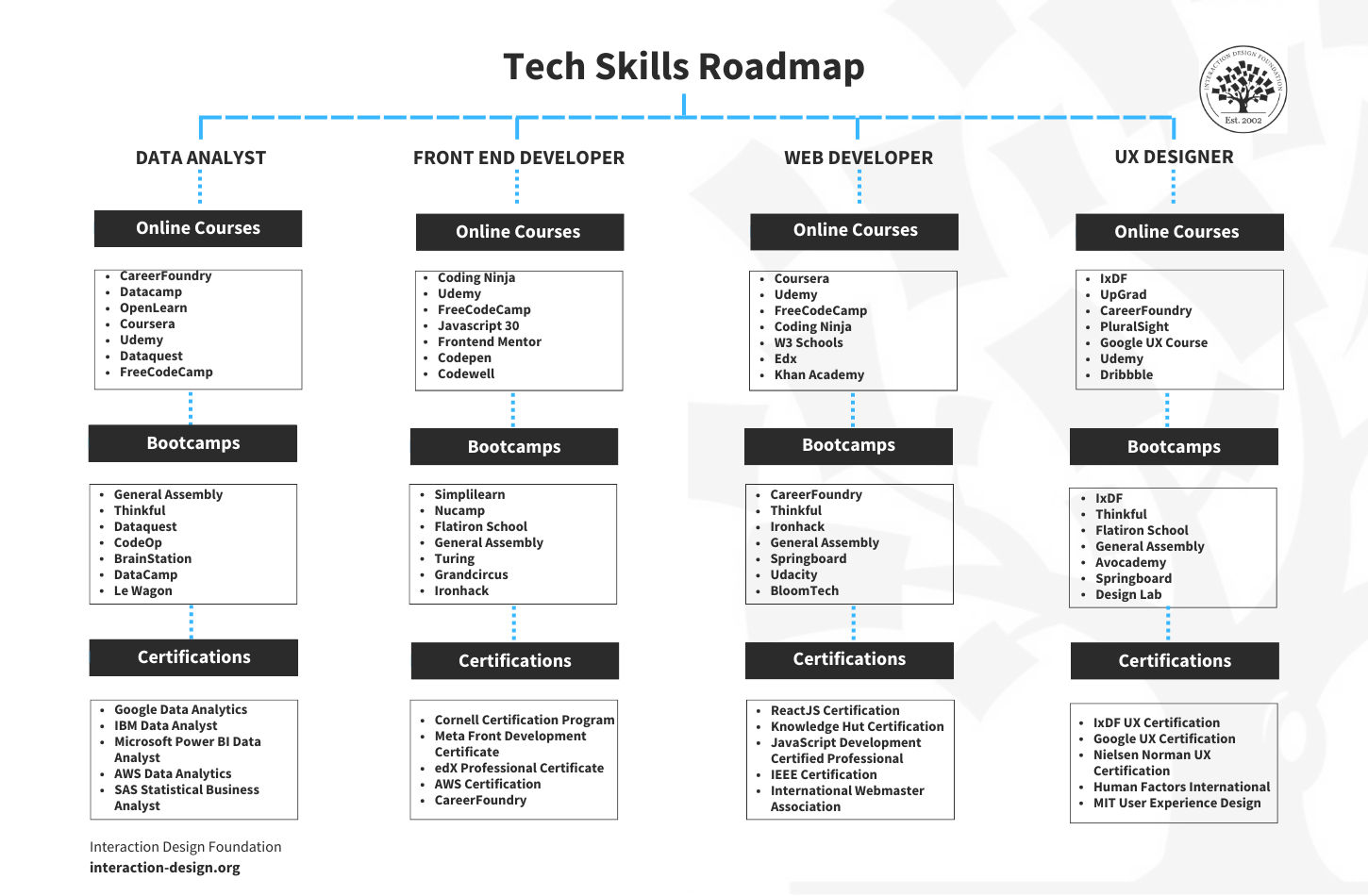
© Interaction Design Foundation, CC BY-SA 4.0
Download this roadmap to plan your tech career path here:
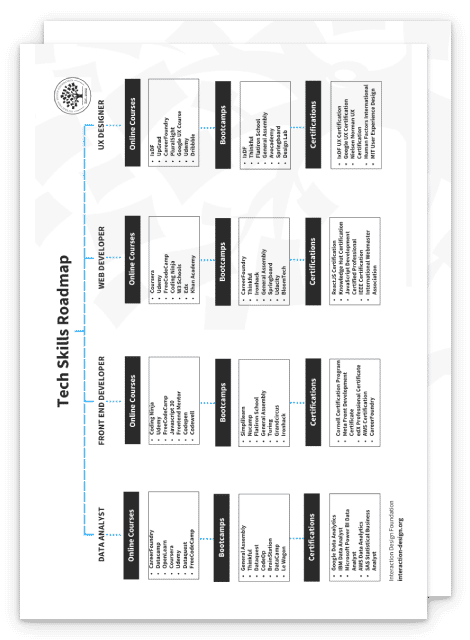

Watch Laura Klein, who uses the analogy of a familiar household activity to explain what it takes to succeed as a designer.
Show
Hide
video transcript
- Transcript loading…
The Take Away
The right tech job is out there—one that fits your interests, skills, and career goals, but it’s going to be a personal decision, so consider exploring various roles, assessing what your strengths are like—and where those gaps might be—and understanding the job market; that’s the way to make an informed choice, and it’ll be one, then, that resonates with you so you can set into the role with passion and not just “stick it out” as a job.
So, are you ready to embark on your journey toward your ideal tech job?
The Interaction Design Foundation can support you every step of the way. Whether you’re interested in UX design or UI design (user interface design) or looking to upskill for your next role, we offer a wide range of courses tailored to your needs.
Get ready to dive deeper. Join our UI/UX courses today and unlock your potential. Visit our website and explore our courses, resources, and services. Your dream tech job awaits, so take that first step!
